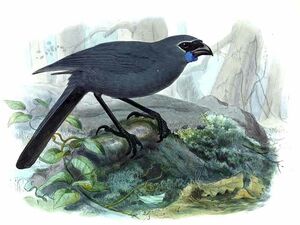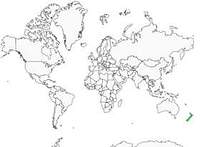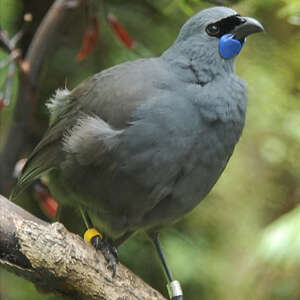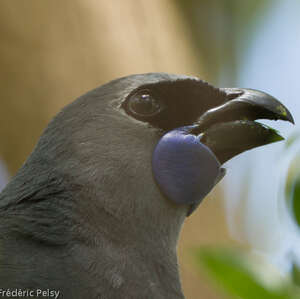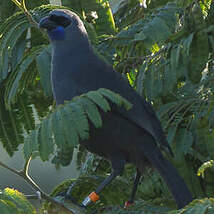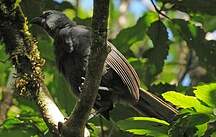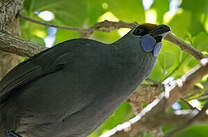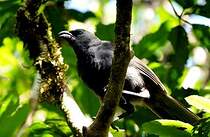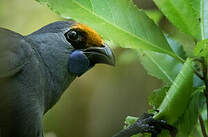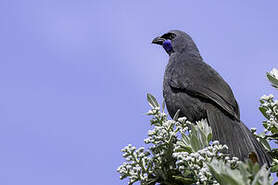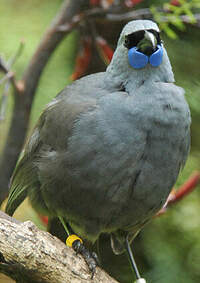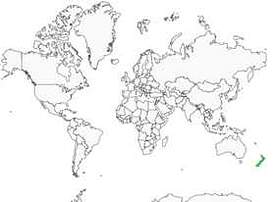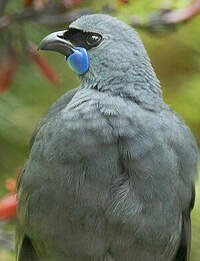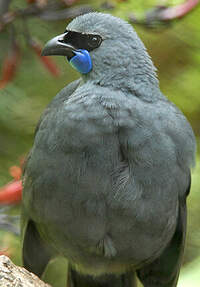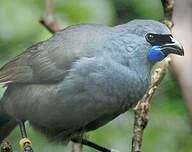North Island Kokako
Callaeas wilsoni - Glaucope de Wilson
Identification
The North Island Kokako, an endemic species, evokes the forests of old New Zealand more than any other species. You are more likely to hear it than see it. Small populations have survived particularly in the North Island's center and in Te Urewera National Park. It is a typical inhabitant of the high native forest dominated by the tawa tree (Beilschmiedia tawa). Continental populations on the North Island persist only through sustained control of introduced mammalian pests (Rattus norvegicus and Trichosurus vulpecula). All unmonitored populations have gone extinct.
Subspecific information monotypic species
Foreign names
- Glaucope de Wilson,
- Kokako de Isla Norte,
- cocaco-de-barbela-azul,
- Graulappenvogel,
- Noordelijke Kokako,
- nordökokako,
- Nordkokako,
- laločník lesný,
- Nordkokako,
- kookako,
- kokako,
- koralnik modropłatkowy,
- Северный кокако,
- ホクトウハシブトホオダレムクドリ,
- 北岛垂耳鸦,
- nordökokako,
- 北島垂耳鴉,
Voice song and call
Habitat
Behaviour character trait
North Island Kokako defends a large territory throughout the year with complex songs, including in duos with the female. Juvenile dispersal is typically 1.3 km before settling on a territory. Their populations are easily isolated by forest fragmentation. Mist netting is commonly used for their capture with Japanese nets.
Flight
Dietfeeding habits
Reproduction nesting
They generally nest between November and February, after which they molt. The breeding season can last 6 months and there can be up to three clutches in years with high food production.
The nest is located at an average height of 13 m. Two to three pinkish gray eggs, spotted with brown or brown-violet, are laid, and only the female takes care of incubation. The nest is an elevated platform, in the form of an expanded cup. Various vegetation is placed on this platform composed of twigs placed on clumps of epiphytic plants, bordered by tree ferns. Incubation is done by the female alone for 18 days. The two adults feed the chicks. They leave the nest between 32-37 days, and will be completely independent after several months. At the time of fledging they usually stay in the parents' territory for several months, up to a year, while still being fed by the adults. The maximum dispersal is usually less than 2 km from the nesting site.Geographic range
North Island Kokako populations are limited to a few scattered forests in the North Island, particularly in the Waikato, Bay of Plenty and Te Urewera National Park. Since 1981, reintroductions have occurred on Little Barrier Island, Kapiti Island, Tiritiri Matangi, Bruce Mountain Scenic Reserve (Wairarapa), Island Mainland Boundary Stream (Hawke's Bay), Ngapukeriki (East Cape), Ark in the Park (Waitakeres, west of Auckland), Whirinaki and Otanewainuku.
Threats - protection
IUCN conservation status
concern
in the Wild
threatened
evaluated
The North Island Kokako is classified as critically endangered by the IUCN. Predation of nests by rats and possums is the main cause of its disappearance. All current populations must be constantly monitored in order to fight predation by introduced mammals. Controlled and repeated regulation of pests on the continent and in the islands is necessary. Rats and possums are regularly targeted by trapping and poisoning with 1080 during breeding season. The amount of food available affects the number of breeding pairs. Several key populations are restored through the reintroduction of young females from different source populations. The maintenance of genetic health also has an influence on the management of the species.
Sources of information
- IOC World Bird List (v15.1), Gill, F and D Donsker (Eds). 2025-12-07.
- xeno-canto, Sharing bird sounds from around the world,
- ARKive, Christopher Parsons
- Avibase, Lepage Denis
- Conservation-comments-NZ,
- New Zealand birds and birding, Narena Olliver
- IUCN Red List of Threatened species,
- Handbook of the birds of the world Vol.14, josep del Hoyo
Other sources of interest
 Specification sheet created on
03/08/2023 by Yann Cambon
Specification sheet created on
03/08/2023 by Yann CambonTranslation by AI Oiseaux.net
© 1996-2025 Oiseaux.net
- Accipitriformes
- Aegotheliformes
- Anseriformes
- Apodiformes
- Apterygiformes
- Bucerotiformes
- Caprimulgiformes
- Cariamiformes
- Casuariiformes
- Charadriiformes
- Ciconiiformes
- Coliiformes
- Columbiformes
- Coraciiformes
- Cuculiformes
- Eurypygiformes
- Falconiformes
- Galliformes
- Gaviiformes
- Gruiformes
- Leptosomiformes
- Mesitornithiformes
- Musophagiformes
- Nyctibiiformes
- Opisthocomiformes
- Otidiformes
- Passeriformes
- Pelecaniformes
- Phaethontiformes
- Phoenicopteriformes
- Piciformes
- Podargiformes
- Podicipediformes
- Procellariiformes
- Psittaciformes
- Pterocliformes
- Rheiformes
- Sphenisciformes
- Steatornithiformes
- Strigiformes
- Struthioniformes
- Suliformes
- Tinamiformes
- Trogoniformes

